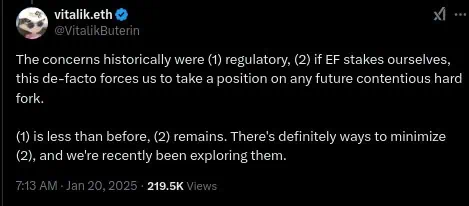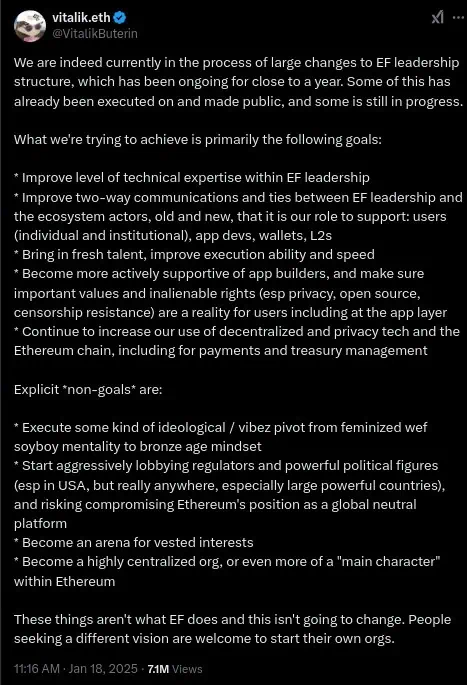
Vitalik Buterin details why the Ethereum Foundation has avoided staking its ETH until now and how the current regulatory environment could change this decision.
Buterin has revealed that the Ethereum Foundation is considering staking a portion of its ETH reserves, a move that would mark a strategic shift in the management of the organization's assets, which currently hold 268.774 ETH, valued at approximately $897 million.
Buterin explained that, until now, the Foundation had avoided staking its ETH due to two main concerns: regulatory risks and need to take a stand in the event of contentious hard forks. However, he also noted that the regulatory environment has improved significantly in recent years, which has reduced these risks and opened the door to a possible reconsideration.
The risks of staking for the Ethereum Foundation
In a recent post on X, Buterin detailed the reasons why the Ethereum Foundation had avoided staking its ETH. The first concern was regulatory risk. Since staking involves active participation in the network, it could expose the Foundation to increased scrutiny from regulatory authorities, especially in jurisdictions with ambiguous legal frameworks for cryptocurrencies.
The second concern, Buterin explained, was the possibility of having to take a position in the event of a contentious hard fork.

Buterin also highlighted that while these concerns remain relevant, the current regulatory environment is more favorable than in previous years. This has led the Foundation to explore options to minimize these risks and consider staking as a way to generate returns to cover its operating expenses.
The growing pressure from the community
The Ethereum Foundation’s decision to consider staking comes in response to criticism from community members, who have argued that the Foundation could use its ETH reserves more efficiently. In a recent post, angel investor Eric Conner joked that the Ethereum Foundation’s “#1 use case” was “ETH dumping.”
Conner suggested that the Foundation could stake its ETH and use decentralized finance (DeFi) tools to cover most, if not all, of its internal budget. This proposal has gained traction within the community, prompting Buterin to publicly address concerns and explain the challenges associated with staking the ethers held by the Foundation.
The five key goals of the Ethereum Foundation restructuring
In addition to addressing the issue of staking, Buterin has also outlined five key goals that will guide the restructuring of the Ethereum Foundation.
In X, Buterin wrote that these goals reflect a renewed focus on privacy, decentralization and the sustainable development, responding to the growing demands of a community seeking more robust and secure solutions.

One of the main goals Buterin talked about for the restructuring of the Foundation is improve the technical experience of the teamIn this regard, the Foundation aims to strengthen its technical capabilities by recruiting new talent and investing in research and development, which will not only ensure that Ethereum maintains its leadership in innovation, but will also enable a more agile response to ecosystem challenges.
In addition, Buterin explained that he is looking for foster more effective communication with developersIn this regard, he stressed the need to establish more open and transparent channels to facilitate the exchange of information and receive feedback. This improvement in communication is essential to build a solid relationship between the Foundation and the developers who contribute to the growth of Ethereum.
On the other hand, Buterin spoke of Attracting new talent to the ecosystem as a priority. He indicated that the Foundation is committed to implementing educational programs, scholarships and financial support to promote innovative projects, enriching the available talent and contributing to a more dynamic and competitive environment.
Also, the Support for decentralized application (dApp) creators This is essential according to Buterin, who pointed out the importance of providing resources and technical assistance to these developers, which includes everything from creating tools to documentation that facilitates their work.
Finally, in a context where security and privacy concerns are increasingly relevant, Buterin said that the Foundation is committed to Develop privacy-focused technologiesThis will allow for more secure transactions without compromising the transparency that characterizes the blockchain.
In short, these goals reflect a significant effort by the Ethereum Foundation to adapt to an ever-changing environment, thereby ensuring its relevance and effectiveness in the future of the blockchain ecosystem.
A commitment to the development and future of the network
The Ethereum Foundation’s decision to consider staking its ETH and restructuring its strategic goals reflect a conscious effort to adapt to an ever-evolving environment. With a renewed focus on privacy, decentralization, and sustainable development, Ethereum seeks to strengthen its position as a leader in the blockchain space.
Furthermore, the network’s upcoming upgrade, dubbed Pectra and scheduled for March 2025, promises to address critical issues related to scalability and decentralization. These initiatives, combined with Buterin’s proposals to facilitate staking, could democratize participation in the network and foster sustainable growth in the use of decentralized applications and DeFi services.
In conclusion, the changes announced by Vitalik Buterin represent an important step towards consolidating Ethereum as a more robust, secure and accessible platform.
By prioritizing technical expertise, improving communication with developers, and focusing on user rights, Buterin is laying the groundwork for a brighter future for Ethereum and its community.



